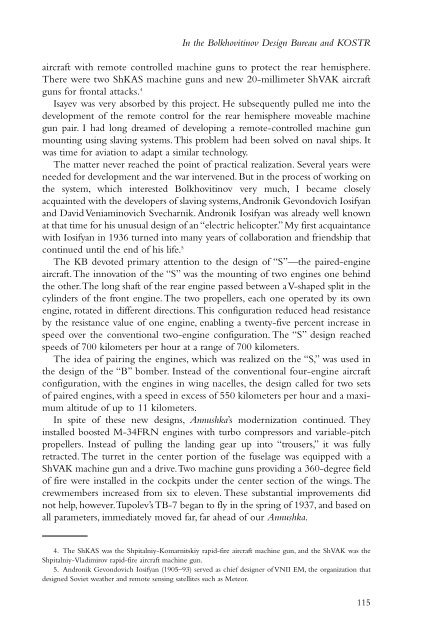to open next chapter. - NASA's History Office
to open next chapter. - NASA's History Office
to open next chapter. - NASA's History Office
You also want an ePaper? Increase the reach of your titles
YUMPU automatically turns print PDFs into web optimized ePapers that Google loves.
In the Bolkhovitinov Design Bureau and KOSTR<br />
aircraft with remote controlled machine guns <strong>to</strong> protect the rear hemisphere.<br />
There were two ShKAS machine guns and new 20-millimeter ShVAK aircraft<br />
guns for frontal attacks. 4<br />
Isayev was very absorbed by this project. He subsequently pulled me in<strong>to</strong> the<br />
development of the remote control for the rear hemisphere moveable machine<br />
gun pair. I had long dreamed of developing a remote-controlled machine gun<br />
mounting using slaving systems.This problem had been solved on naval ships. It<br />
was time for aviation <strong>to</strong> adapt a similar technology.<br />
The matter never reached the point of practical realization. Several years were<br />
needed for development and the war intervened. But in the process of working on<br />
the system, which interested Bolkhovitinov very much, I became closely<br />
acquainted with the developers of slaving systems,Andronik Gevondovich Iosifyan<br />
and David Veniaminovich Svecharnik. Andronik Iosifyan was already well known<br />
at that time for his unusual design of an “electric helicopter.” My first acquaintance<br />
with Iosifyan in 1936 turned in<strong>to</strong> many years of collaboration and friendship that<br />
continued until the end of his life. 5<br />
The KB devoted primary attention <strong>to</strong> the design of “S”—the paired-engine<br />
aircraft.The innovation of the “S” was the mounting of two engines one behind<br />
the other.The long shaft of the rear engine passed between a V-shaped split in the<br />
cylinders of the front engine. The two propellers, each one operated by its own<br />
engine, rotated in different directions.This configuration reduced head resistance<br />
by the resistance value of one engine, enabling a twenty-five percent increase in<br />
speed over the conventional two-engine configuration. The “S” design reached<br />
speeds of 700 kilometers per hour at a range of 700 kilometers.<br />
The idea of pairing the engines, which was realized on the “S,” was used in<br />
the design of the “B” bomber. Instead of the conventional four-engine aircraft<br />
configuration, with the engines in wing nacelles, the design called for two sets<br />
of paired engines, with a speed in excess of 550 kilometers per hour and a maximum<br />
altitude of up <strong>to</strong> 11 kilometers.<br />
In spite of these new designs, Annushka’s modernization continued. They<br />
installed boosted M-34FRN engines with turbo compressors and variable-pitch<br />
propellers. Instead of pulling the landing gear up in<strong>to</strong> “trousers,” it was fully<br />
retracted. The turret in the center portion of the fuselage was equipped with a<br />
ShVAK machine gun and a drive.Two machine guns providing a 360-degree field<br />
of fire were installed in the cockpits under the center section of the wings. The<br />
crewmembers increased from six <strong>to</strong> eleven. These substantial improvements did<br />
not help, however.Tupolev’s TB-7 began <strong>to</strong> fly in the spring of 1937, and based on<br />
all parameters, immediately moved far, far ahead of our Annushka.<br />
4. The ShKAS was the Shpitalniy-Komarnitskiy rapid-fire aircraft machine gun, and the ShVAK was the<br />
Shpitalniy-Vladimirov rapid-fire aircraft machine gun.<br />
5. Andronik Gevondovich Iosifyan (1905–93) served as chief designer of VNII EM, the organization that<br />
designed Soviet weather and remote sensing satellites such as Meteor.<br />
115
















